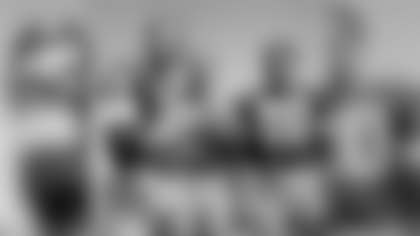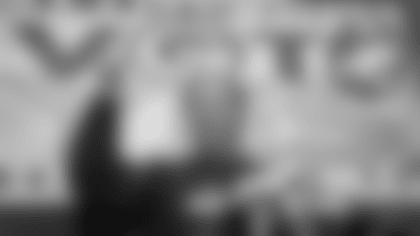Greg from Knoxville, TN
I've enjoyed your Packers coverage for years. No one could have been a better choice for Packers historian. Now, can you tell me how long James Lofton and John Jefferson were on the team together? How did their stats match up with other duos? As I recall, JJ was in the twilight of his career and had a limited number of receptions.
Greg, let me start by thanking you for the kind words, and thanking you and others for being loyal readers.
Lofton and Jefferson played four years together in Green Bay, although it should be noted that Jefferson didn't join the Packers until the fourth week of the 1981 season and played only eight games in the strike-shortened 1982 season.

In 1980, in Jefferson's final season with San Diego, he caught 82 passes for 1,340 yards, a 16.3 average, with 13 TDs. At that point, three years into their careers, Jefferson had more catches, more yards and a 36-14 lead in touchdown receptions over Lofton. Jefferson appeared to be the one on path to a Hall of Fame career. But he was never the same player in Green Bay. His best season with the Packers was 1983 when he caught 57 passes for 830 yards, a 14.6 average, with 7 TDs.
It wasn't that Jefferson was in the twilight of his career when the Packers obtained him. He was only 25 years old and a product of the same draft as Lofton. The Packers gave up a bundle to get him: A first-round draft pick, two seconds and veteran Aundra Thompson. But Jefferson didn't have Lofton's speed and wasn't a good fit for the Packers' vertical passing game. What's more, he was an Arizona State product and seemed out of his environment, if not unhappy about playing in Green Bay.
Lofton and Jefferson was an impressive pairing on paper, but that wasn't necessarily reality.
I was working for the Green Bay Press-Gazette at the time and wrote a story in 1982 where I interviewed four of my NFL contacts and asked how they compared the Packers' talent at the offensive skill positions to the rest of the league. Two of the people I quoted were defensive coordinators Tom Bass and Joe Gardi. One of the personnel people was Allan Webb, one of the first black assistant coaches in the NFL and Cleveland's director of pro personnel at the time. The other was Ernie Adams, then pro personnel director of the New York Giants; and now, for the past 17 years, the mysterious, behind-the-scenes football research director for Bill Belichick in New England.
Adams told me at the time that he rated the Packers' skill players – that also included quarterback Lynn Dickey, tight end Paul Coffman, and running backs Eddie Lee Ivery and Gerry Ellis – a notch below Dallas, San Diego and Cincinnati. Adams rated San Diego's Dan Fouts and Cincinnati's Ken Anderson better than Dickey and Dallas' Danny White the equal of Dickey. He also gave Dallas, with Tony Dorsett, a big edge at running back.
Webb gave an edge to the same three teams as Adams, but also thought Pittsburgh, Atlanta and Buffalo had better skill people than the Packers. Most notably, he said Pittsburgh had a big edge at quarterback with Terry Bradshaw. And along with the Cowboys, Webb gave the Chargers with Chuck Muncie, the Bengals with Pete Johnson and the Bills with Joe Cribbs an advantage at running back.
But Adams, Webb, Bass and Gardi agreed the Packers' wide receivers were as good as any other pair. Only one of them, who asked to remain anonymous on that subject, expressed any reservations. He questioned whether the Packers were getting the most out of their talent.
"They may have the skill," the source said, "but they don't get the ball to them."
As for your question about stats, Lofton finished in the top 10 in the NFL in catches twice and in yardage the two other years he played with Jefferson. But Jefferson never ranked in the top 10 in either category.
David from Memphis, TN
I just read a short blurb in the local Memphis paper about a pro football franchise in the late 1920s. The Commercial Appeal said the Packers came down to Memphis after winning the NFL championship and lost to the local team. Can you shed any light on that?
No doubt, it's one of the more bizarre and maybe embarrassing stories in Packers history. In 1929, the Packers not only won their first NFL championship, they completely dominated their opponents. They went 12-0-1 in league play and outscored the opposition, 198-22.

The Packers clinched the title, determined at the time by the final regular-season standings, in their final league game by beating the Bears, 25-0, in Chicago. The next week, the Packers went to Memphis to play an exhibition against the Memphis Tigers, an independent professional team, and lost, 20-6.
The game was arranged by Curly Lambeau and Clarence Saunders, who was manager of the Tigers and a prominent Memphis businessman. In 1916, Saunders had founded Piggly Wiggly, the country's first self-service grocery store.
Lambeau's players apparently were on board with the decision to play the game even though they had nothing to gain and everything to lose. "This post-season schedule has met with favor of the players as it will give them an opportunity to harvest a bit more Christmas money," the Green Bay Press-Gazette reported on Dec. 5.
That same day, noted sports historian Frank Menke, whose columns appeared in 300 newspapers daily, declared the Packers' "the greatest team ever welded together."
But after beating the Bears, the Packers spent the next week living the good life. They were welcomed home by an estimated 20,000 fans, honored at a public dinner and given a $5,000 purse by the community to share. Then they left for Memphis on a 1:15 a.m. train the day before the game.
The Tigers were a formidable team that played a tough independent schedule, but they had lost to the Bears, 39-12, in a previous exhibition game less than a month earlier.
That, no doubt, drove Saunders to load up for the game against the Packers. He signed Ken Strong, a future Pro Football Hall of Famer who had starred for the Staten Island Stapletons that season; Doug Wycoff, another Stapleton standout; Joe Kopcha of the Bears; Jess Tinsley and Jacob Williams of the Chicago Cardinals; and several former college stars. In essence, Saunders had assembled an all-star team.
The Packers-Tigers game drew an estimated 8,000 fans, 2,000 more than the Packers-Bears game had drawn the week before, so it was a good payday for the players. But the Packers were badly outplayed and humbled. Memphis fans claimed the Tigers, not the Packers, were national champions.
The Press-Gazette disagreed in an editorial and said Packers fans shouldn't take the game to heart. It stated, "(The players) did not appear under the auspices or management of the football corporation. It was their own private expedition."
Lambeau blamed the heat and injuries for his team's poor play. But he also admitted, "The game yesterday was the roughest we have ever played."
Meanwhile, Saunders scheduled another game with the Bears and three Packers – Johnny Blood, Cal Hubbard and Bill Kern – remained in Memphis with the intention of playing for the Tigers. When the Tigers beat the Bears, 16-6, a week later, Saunders laid claim "to professional football supremacy of the nation."
The following season, the Tigers fielded a team again and invited the Packers to Memphis after they had won a second straight title, but negotiations fell through.
Dennis from Naples, FL
We had Ted Hendricks for one year in 1974. He had one of the best years of any Packers linebacker in the last 50 years. I don't remember how we acquired him. Even more perplexing, in that era before free agency, how on God's green earth did we not keep him?
Dean of Leavenworth, Ind., asked the same question and I'll start my answer with an even stronger statement than yours. I think Hendricks had the greatest season of any defensive player the Packers have had in the last 50 years, going back to the end of the Vince Lombardi era. I don't believe Reggie White ever had a better year in Green Bay.
Hendricks blocked seven kicks, including three field goals and three punts. He intercepted five passes. He scored a safety in a 21-19 victory. He made plays like few defenders ever have in a single season.
Dan Devine had acquired Hendricks from the Baltimore Colts a month before the start of the 1974 season. Hendricks planned to play out his NFL option after signing with the Jacksonville Sharks of the World Football League. Because there was no guarantee the Packers would have Hendricks for more than a season, the trade was a gamble and criticized by some. The Packers gave up promising young linebacker Tom McLeod and an eighth-round draft pick for Hendricks and a second-round choice.
But Hendricks was just 26 and already a three-time Pro Bowl pick. Then he had a Pro Bowl year for the Packers and also was named Associated Press All-Pro. In the meantime, the Sharks folded and Bart Starr replaced Devine as Packers coach and general manager.
Within two months, NFL teams were given permission to contact WFL players who had their contracts breached and the Packers followed up with Hendricks.
However, by early May, Hendricks' contract talks with the Packers stalled and he blamed it on Starr taking a hardline stance. The talks essentially ceased on July 22, when Hendricks came to Green Bay to meet face-to-face with the Packers. A roughly 90-minute negotiating session ended with Hendricks' agent, Tony Roberts, stating, "It's over. There's no chance of coming back and talking."
Finally on Aug. 6, after three months where Hendricks could also entertain offers from other teams, he agreed to a three-year contract with Oakland. Then it took more than another month before the two teams were able to agree on compensation. In the end, the Packers were awarded two No. 1 draft picks that turned out to be Mark Koncar and Ezra Johnson.
Hendricks played nine more seasons and was inducted into the Pro Football Hall of Fame in 1990. And Dennis, you're right. Allowing Hendricks to walk was one of the worst personnel decisions of the Packers' 24-year drought between Lombardi and Ron Wolf.
Chuck from Hartland, WI
The 1942 Lions went 0-11, were outscored 263 to 38 and threw a total of one TD pass and 33 interceptions. How could this even be true? I grew up watching the 1970s Packers and Bears, and the Les Steckel Vikings, but, in your opinion, do the 1942 Lions rank as the worst ever team from the current NFC North members?
Interesting question and mind-boggling numbers.
To start, that was the first NFL season following the bombing of Pearl Harbor and the Lions lost 49 players that previously had been under contract. So talent across the league was diluted. But, statistically, I can't imagine another team being worse, not even the 2008, 0-16 Lions.
Here's another stat to digest: Those 1942 Lions scored only five touchdowns in 11 games and gave up 37.
The Packers beat them, 38-7, on Oct. 11 in Milwaukee and then, 28-7, two weeks later in Detroit. In the first game, playing only a half, Cecil Isbell completed 7 of 9 passes for 170 yards, and Don Hutson caught five passes for 149 yards, a 29.8 average per catch. In the second game, Andy Uram returned a kickoff 98 yards for the Packers.
Matt from Foxboro, MA
My grandmother was in town and dropped it on me during a Packers game that I'm related to Andy Muldoon via my grandfather. Andy was his uncle. Looks like he played in 1919. Would you have any additional info about Andy?
Yes, Andy Muldoon was one of the original Packers in 1919. He played left and right tackle in the team's first-ever game on Sept. 14, 1919. Then he started the second game at left tackle. In all, he played in eight of 11 games that first season and started one.
Many of the original Packers played at Green Bay West High School against Curly Lambeau or at Green Bay East with Lambeau from 1913-16. Muldoon was one of the exceptions. A native of Felch, Mich., and in his late 20s, he was one of the older players on the team. He had started playing with the Hillside Boys, a Green Bay team with a 115-pound weight limit, as a teenager in 1906.
Subsequently, he played on several local amateur teams before entering the service in 1918. He was discharged in March 1919 and the Packers were formed five months later.















